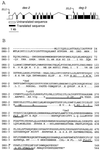Two functionally dependent acetylcholine subunits are encoded in a single Caenorhabditis elegans operon
- PMID: 9860996
- PMCID: PMC28070
- DOI: 10.1073/pnas.95.26.15492
Two functionally dependent acetylcholine subunits are encoded in a single Caenorhabditis elegans operon
Abstract
The deg-3 gene from the nematode Caenorhabditis elegans encodes an alpha subunit of a nicotinic acetylcholine receptor that was first identified by a dominant allele, u662, which produced neuronal degeneration. Because deg-3 cDNAs contain the SL2 trans-spliced leader, we suggested that deg-3 was transcribed as part of a C. elegans operon. Here we show that des-2, a gene in which mutations suppress deg-3(u662), is the upstream gene in that operon. The des-2 gene also encodes an alpha subunit of a nicotinic acetylcholine receptor. As expected for genes whose mRNAs are formed from a single transcript, both genes have similar expression patterns. This coexpression is functionally important because (i) des-2 is needed for the deg-3(u662) degenerations in vivo; (ii) an acetylcholine-gated channel is formed in Xenopus oocytes when both subunits are expressed but not when either is expressed alone; and (iii) channel activity, albeit apparently altered from that of the wild-type channel, results from the expression of a u662-type mutant subunit but, again, only when the wild-type DES-2 subunit is present. Thus, the operon structure appears to regulate the coordinate expression of two channel subunits.
Figures



References
-
- Blumenthal T, Spieth J. Curr Opin Genet Dev. 1996;6:692–698. - PubMed
-
- Blumenthal T, Steward K. In: Caenorhabditis elegans II. Riddle D L, Blumenthal T, Meyer B J, Priess J R, editors. Plainview, NY: Cold Spring Harbor Lab. Press; 1997. pp. 117–145.
-
- Spieth J, Brooke G, Kuersten S, Lea K, Blumenthal T. Cell. 1993;73:521–532. - PubMed
-
- Page A P. DNA Cell Biol. 1997;16:1335–1343. - PubMed
Publication types
MeSH terms
Substances
Associated data
- Actions
Grants and funding
LinkOut - more resources
Full Text Sources
Research Materials

